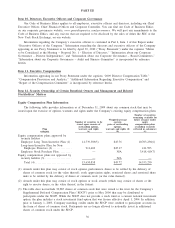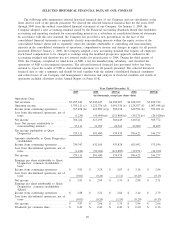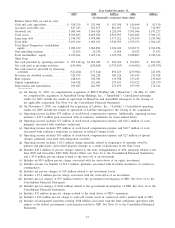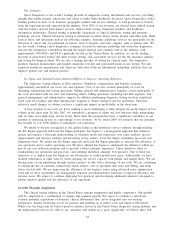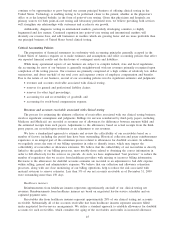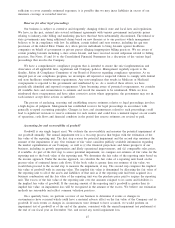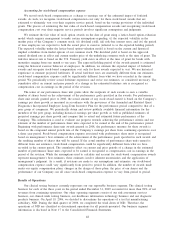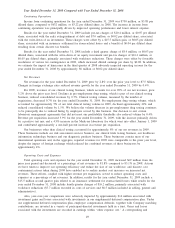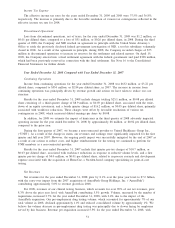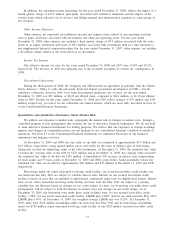Quest Diagnostics 2009 Annual Report Download - page 55
Download and view the complete annual report
Please find page 55 of the 2009 Quest Diagnostics annual report below. You can navigate through the pages in the report by either clicking on the pages listed below, or by using the keyword search tool below to find specific information within the annual report.continue to be opportunities to grow beyond our current principal business of offering clinical testing in the
United States. Technology is enabling testing to be performed closer to the patient, whether in the physician’s
office or at the hospital bedside, in the form of point-of-care testing. Given that physicians and hospitals are
primary sources for both point-of-care testing and laboratory performed tests, we believe providing both services
will strengthen our relationships with customers and accelerate our growth.
Additionally, diagnostic testing in international markets, particularly developing countries, is highly
fragmented and less mature. Continued expansion into point-of-care testing and international markets will
diversify our revenue base, and add businesses in markets which are growing faster and are more profitable than
our principal business of United States based clinical testing.
Critical Accounting Policies
The preparation of financial statements in conformity with accounting principles generally accepted in the
United States of America requires us to make estimates and assumptions and select accounting policies that affect
our reported financial results and the disclosure of contingent assets and liabilities.
While many operational aspects of our business are subject to complex federal, state and local regulations,
the accounting for most of our business is generally straightforward with net revenues primarily recognized upon
completion of the testing process. Our revenues are primarily comprised of a high volume of relatively low dollar
transactions, and about one-half of our total costs and expenses consist of employee compensation and benefits.
Due to the nature of our business, several of our accounting policies involve significant estimates and judgments:
•revenues and accounts receivable associated with clinical testing;
•reserves for general and professional liability claims;
•reserves for other legal proceedings;
•accounting for and recoverability of goodwill; and
•accounting for stock-based compensation expense.
Revenues and accounts receivable associated with clinical testing
The process for estimating the ultimate collection of receivables associated with our clinical testing business
involves significant assumptions and judgments. Billings for services reimbursed by third-party payers, including
Medicare and Medicaid, are recorded as revenues net of allowances for differences between amounts billed and
the estimated receipts from such payers. Adjustments to the allowances, based on actual receipts from the third-
party payers, are recorded upon settlement as an adjustment to net revenues.
We have a standardized approach to estimate and review the collectibility of our receivables based on a
number of factors, including the period they have been outstanding. Historical collection and payer reimbursement
experience is an integral part of the estimation process related to allowances for doubtful accounts. In addition,
we regularly assess the state of our billing operations in order to identify issues, which may impact the
collectibility of receivables or allowance estimates. We believe that the collectibility of our receivables is directly
linked to the quality of our billing processes, most notably those related to obtaining the correct information in
order to bill effectively for the services we provide. As such, we have implemented “best practices” to reduce the
number of requisitions that we receive from healthcare providers with missing or incorrect billing information.
Revisions to the allowances for doubtful accounts estimates are recorded as an adjustment to bad debt expense
within selling, general and administrative expenses. We believe that our collection and allowance estimation
processes, along with our close monitoring of our billing operations, help to reduce the risk associated with
material revisions to reserve estimates. Less than 5% of our net accounts receivable as of December 31, 2009
were outstanding more than 150 days.
Healthcare insurers
Reimbursements from healthcare insurers represents approximately one-half of our clinical testing net
revenues. Reimbursements from healthcare insurers are based on negotiated fee-for-service schedules and on
capitated payment rates.
Receivables due from healthcare insurers represent approximately 28% of our clinical testing net accounts
receivable. Substantially all of the accounts receivable due from healthcare insurers represent amounts billed
under negotiated fee-for-service arrangements. We utilize a standard approach to establish allowances for doubtful
accounts for such receivables, which considers the aging of the receivables and results in increased allowance
45



